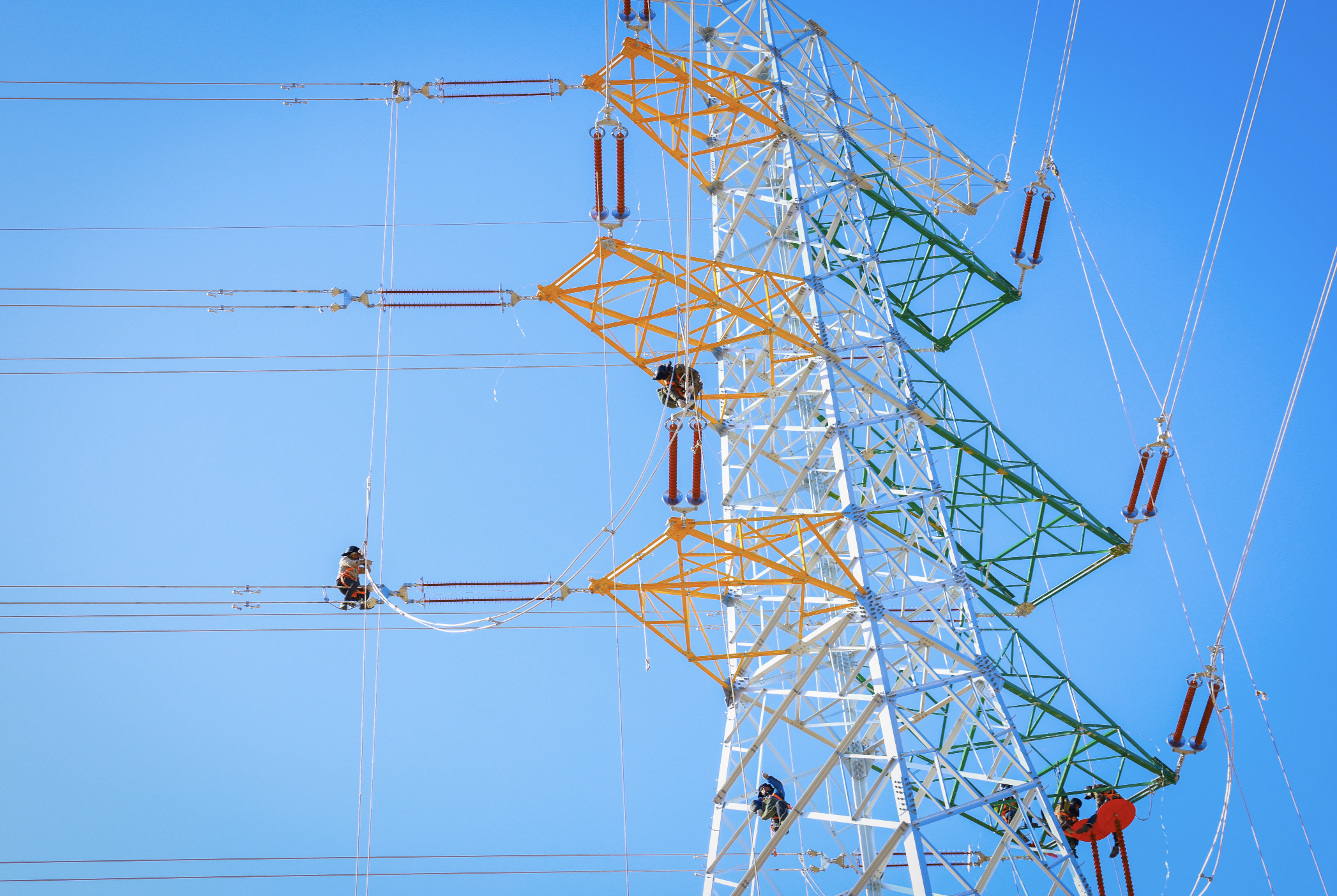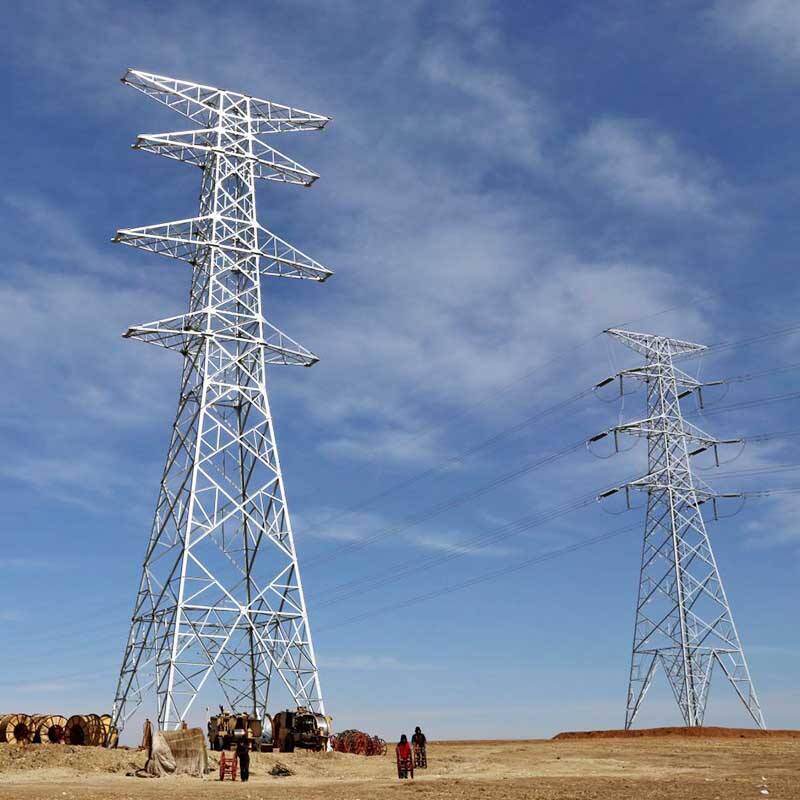Հիմնական գործառույթային կատեգորիաներ Էլեկտրական աշտարակներ
Կախովի աշտարակներ՝ հաղորդալարերի առանց ուղղության փոփոխությամբ
Կախովի աշտարակները բարձր լարման էլեկտրահաղորդման գծերի հիմնարար մասն են կազմում, որոնք նախագծված են հենց այդ նպատակի համար՝ պահել օդային հաղորդալարերը և ապահովել դրանց ուղիղ ընթացքը: Այս աշտարակների կարևորությունը այն է, որ դրանք հնարավորություն են տալիս ստեղծել երկար հատվածներ հենարանների միջև, թույլատվելով էլեկտրաէներգիայի անխափան տեղափոխում: Ըստ էության, աշտարակները վերցնում են այդ ծանր հաղորդալարերի բեռը, պահելով դրանք այնքան լարված, որպեսզի կանխվի դրանց ճոճվելը, որը կարող է հետագա խնդիրներ առաջացնել: Շատ հաճախ ինժեներները այս կառույցները տեղադրում են ուղիղ ճանապարհներով, որտեղ դրանք ամենալավ ձևով կարող են իրենց առաքելությունը կատարել: Դրանք անհրաժեշտ են էլեկտրաէներգիայի փոխադրման համար մեծ տարածքներով, ապահովելով տների և ձեռնարկությունների կապը, նույնիսկ այն դեպքում, երբ ենթակայանների միջև հեռավորությունը մեծ է:
Լարման աշտարակներ՝ հաղորդալարերի անկյուններում և հատվածների վերջերում ամրացում
Երբ անհրաժեշտ է փոխել հոսանքա carrying ի հաղորդման գծերի ուղղությունը, լարման աշտարակները դառնում են անհրաժեշտ: Այս կառույցները հնարավորություն են տալիս ամրացնել հիմնարար կետերը հաղորդման գծերի երկայնքով, որպեսզի կառավարեն լարումը, որը առաջանում է, հատկապես լեռնային տարածքներում կամ հովտերի վրայով անցնող կոր տեղերում: Լարման աշտարակների նախագիծը պետք է շատ ամուր լինի, քանի որ ամենօրյա շրջակա միջավայրի մարտահանդեսների դեմ են դիմակայում: Պատկերացրեք, թե քամին ժամերով հարվածում է նրանց, կամ ձմեռային փոթորիկների դեպքում սառույցը բարակներով է կուտակվում: Այս ամենը ապահովում է, որ էլեկտրական հաղորդալարերը ամբողջությամբ ամրացված մնան անկախ նրանից, թե ինչ է նետում մեզ բնությունը: Առանց այս կառուցվածքային ամրության, մեր էլեկտրական ցանցը դժվարադեպում կմնար դժվարանցանելի լանդշաֆտներում, որտեղ ուղիղ ճանապարհներ հնարավոր չէ անել:
Տրանսպոզիցիոն աշտարակներ. Էլեկտրական բեռների հավասարակշռում դիրքի ճշգրտմամբ
Տրանսպոնիրող աշտարակները նախագծված են հիմնականում հաղորդալարերը իրենց առանցքների շուրջը պտտելու համար, ինչը օգնում է հավասարակշռել էլեկտրական բեռնվածքները տարբեր փուլերի միջև: Երբ այդ բեռնվածքները ճիշտ կերպով հավասարակշռված են, կրճատվում է էներգիայի կորուստը և ամբողջ էլեկտրական ցանցը ավելի արդյունավետ է աշխատում: Ճյուղավորման գծերի երկայնքով ինժեներները այդ աշտարակները տեղադրում են հիմնարար կետերում, որպեսզի ցանցում պահպանեն էլեկտրական հավասարակշռությունը: Սա կանխում է այդ անհարմար հարմոնիկ դեֆորմացիաների կուտակումը, որը իրականում խաթարում է համակարգով էներգիայի հոսքի արդյունավետությունը: Առանց այդ հավասարակշռման, մենք տներում և ձեռնարկություններում կտեսնենք տարբեր խնդիրներ, երբ փորձում ենք սովորական կերպով աշխատեցնել սարքեր և սարքավորումներ:
Էլեկտրական աշտարակների կոնստրուկտիվ նախագծման տարբերակներ
Բջջային աշտարակներ. բարձր լարման գծերի համար խաչաձև պողպատե կոնստրուկցիա
Բջջային աշտարակները երկար հեռավորությունների վրա բարձր լարման էլեկտրաէներգիայի հաղորդման համար ստանդարտ սարքավորումներ են դարձել իրենց հստակ խաչաձև պողպատե շրջանակների շնորհիվ: Այդ աշտարակների կառուցման եղանակը նրանց տալիս է արտակարգ ուժ, մինչդեռ նյութերի արդյունավետ օգտագործման շնորհիվ ընկերությունները փող են խնայում՝ որակից չհրաժարվելով: Այդ կառույցները կարողանում են կրել հսկայական էլեկտրական բեռներ առանց խնդիրների և դիմանում են վատ եղանակներին, ինչը շատ կարևոր է հատկապես երբ էլեկտրահաղորդման գծերը տեղակայվում են լեռնային տարածքներով կամ փոթորիկների ենթակա ծովափնյա շրջաններով: Ընթադրական անձնակազմը գնահատում է բաց դիզայնը, քանի որ աշտարակի տարբեր մասերին հասնելը ստուգումների կամ նորոգումների ընթացքում հեշտանում է, ապահովելով գործողությունների հարթ ընթացքը մեծ մաս ժամանակ: Բացի այդ, քանի որ բջջային աշտարակները հողի ավելի քիչ տարածք են զբաղեցնում մյուս տարբերակների համեմատ, դրանք հարմար են ճանապարհների, արդյունաբերական կամ քաղաքային տարածքների մոտ, որտեղ հողի պաշարները սահմանափակ են:
Մոնոպոլ աշտարակներ. միապոլ քաղաքային լուծումներ
Երբ քաղաքները տեղ չեն ունենում, մոնոպոլային աշտարակները ավելի խելացի ընտրություն են առաջարկում խոշոր կառույցների դեպքում: Գործնականում դա մեկ ուժեղ պողպատե ձող է, որը կանգնած է մենակ, և այն հակադրվում է եղանակին և չի դուրս ցցվում ամեն տեղ այնպես, ինչպես մյուսները: Քաղաքային պաշտոնյաները սիրում են դրանք, քանի որ խնայում են գումար և ավելի արագ տեղադրվում են մյուս տարբերակների համեմատ: Վերցրեք օրինակ կենտրոնական շրջանները, որտեղ յուրաքանչյուր քառակուսի ոտք կարևոր է: Պարզ ձևը նշանակում է, որ աշխատանքային խմբերը դրանք ավելի արագ կարող են տեղադրել՝ առանց փողոցների կամ զբոսայգիների մեծ վնասման: Բացի այդ, դրանց տեսքի մեջ մարդիկ ավելի հարմարավետ են զգում խիտ բնակեցված տարածքներում: Դրանք չեն ստեղծում այն տգեղ անտենաների անտառները, ինչպես այլ տեղերում, սակայն կարողանում են կրել բոլոր ազդանշանները, որոնք անհրաժեշտ են ժամանակակից հեռահաղորդակցության ենթակառուցվածքների համար:
Բաց աշտարակներ. Տարածքային արդյունավետ դատարկ ձևեր
Շինական աշտարակները առանձնանում են, քանի որ տեղ են զբաղեցնում ավելի քիչ, քան ավանդական դիզայնները: Այս աշտարակները հիմնականում աշխատում են որպես խորաններ, որոնք նյութի մեծ ծախս չպահանջելով ապահովում են լավ ամրություն: Ընդհանուր գաղափարն իրականում այս կառուցվածքները միջին հաշվով թեթևացնում է, ինչը նվազեցնում է դրանք տեղափոխելու և հարթակում հավաքելու համար անհրաժեշտ միջոցները: Նրանց շրջանաձև ձևը նաև օգնում է ավելի լավ դիմակայել քամիներին: Քամին պարզապես շրջանցում է դրանք, փոխարենը, որպեսզի գլխավոր ճնշումը կրեն, այդպիսով նվազեցնելով վտանգը ամպրոպների դեպքում: Այն վայրերի համար, որտեղ տեղական պայմանները սահմանափակ են, ինչպես օրինակ քաղաքային միջավայրերում կամ լեռնային տարածքներում, այս աշտարակները շատ տրամաբանական են: Բացի այդ, քանի որ դրանք ամբողջապես ավելի փոքր մակերես են զբաղեցնում, տեղադրությունը սովորաբար պահանջում է ավելի քիչ նյութեր և աշխատանքային ժամեր մյուս տեսակների համեմատ: Շատ կառուցողներ այսօր այս մոտեցումը տեսնում են որպես կանաչ շինարարության մաս, քանի որ երկար ժամանակ տնտեսում է ինչպես գումար, այնպես էլ ռեսուրսներ:
Շեղական աշտարակներ. Կապով աջակցվող բարձր կառուցվածքներ
Շիթապարանոց աշտարակները գերազանցում են մյուս տիպի աշտարակներին իրենց լարված թելերի ցանցի շնորհիվ, որոնք ամբողջ կառուցվածքը միասին են պահում: Այս կառուցվածքի առավելությունն այն է, որ այն կարող է հասնել արտասովոր բարձրությունների՝ առանց շատ շինանյութ օգտագործելու, ինչն էլ փոխարինում է գումարը և նվազեցնում է ռեսուրսների սպառումը: Այս աշտարակները հատկապես լավ են աշխատում բջջային հեռախոսային ազդանշանների և էլեկտրահաղորդման գծերի համար, որոնք անցնում են այն տարածքներով, որտեղ հողը շատ ամուր չէ: Այնուամենայնիվ, շիթապարանների ճիշտ տեղադրումը շատ կարևոր է ամբողջ կառուցվածքի կայունությունն ապահովելու համար: Ճարտարագետները ստիպված են լինում յուրաքանչյուր թել հուսալի տեղադրեն և ամրագրեն: Բացի այդ, նրանք ստիպված են լինում հետևել խիստ անվտանգության կանոններին՝ վթարներից խուսափելու և ծառայությունները երկար տարիներ ապահովելու համար:
Տեղանքին համապատասխան աշտարակների կառուցվածքներ
Լեռնային տարածքների հարմարեցումներ
Լեռնային տարածքներում էլեկտրական աշտարակների նախագծումը մի շարք դժվարացնող խնդիրներ է առաջացնում դժվարանցանելի լեռնային տեղանքի պատճառով: Աշտարակները պետք է հատուկ ձևով փոփոխությունների ենթարկվեն, որպեսզի կարողանան դիմանալ անկողնի թեքություններին և ժայռային հիմքերին, ապահովելով անկումը խուսափել ժայռաթափումների կամ վատ եղանակների դեպքում: Կարևոր է նաև աշտարակի բարձրությունը, քանի որ լեռները ազդում են ինչպես են օդում տեղափոխվում հաղորդակցման ազդանշանները: Ճյուղային ինժեներները ստիպված են լինում հնարամիտ լուծումներ կիրառել իրենց նախագծերում, որպեսզի ամեն ինչ ճիշտ աշխատի և ապահով լինի աշխատողների համար: Որոշ ընկերություններ նույնիսկ փորձնական նմուշներ են թեստավորում նման պայմաններում տեղադրումից առաջ, որպեսզի վաղ փուլում հայտնաբերեն հնարավոր խնդիրները:
Հարթ տեղանքի հեռավորության սահմանափակումներ (Ըստ IS 5613 ստանդարտների)
Չնայած լեռներին, հարթ տարածքները իրենց հատուկ խնդիրներն ունեն էլեկտրահաղորդման գծերի համար: Այստեղ կիրառվում են IS 5613 կանոնակարգերը, քանի որ դրանք նշում են, թե իրարից ինչքան հեռավորության վրա պետք է տեղադրվեն աշտարակները: Այս հեռավորությունն ապահովում է այն, որ հաղորդալարերը չեն շատ թուլանա հենարանների միջև, ինչը կարող է հանգեցնել անվտանգության խնդիրների կամ համակարգի անջատման: Այդ կանոնների հետևումը օգնում է ապահովել համակարգի անխափան աշխատանքը և փոխանակ այդ, փոխարինումների վրա փոխհատուցումներ տալ: Ցանկացած մեկի համար, ով կառուցում է կամ պահպանում է էլեկտրական ցանցեր հարթ տարածքներում, IS 5613-ի հետևումը միայն լավ մատուցում չէ, այլ գործնականում անհրաժեշտ է, եթե ցանցերը ցանկանում են տասնամյակներ ապահովել անընդհատ աշխատանք առանց հաճախադեպ վերանորոգումների և փոխարինումների:

Նյութի բաղադրություն և կառուցման մեթոդներ
Ցինկապատ պողպատ բետոնե հիմքերի դեմ
Էլեկտրական աշտարակներ կառուցողները սովորաբար համեմատում են ցինկապատ պողպատը և բետոնե հիմքերը՝ նյութեր ընտրելիս, քանի որ երկուսն էլ իրենց առավելություններն ունեն: Պողպատը հաճախ ավելի լավ է, քանի որ այն դիմացկուն է, երկար է ծառայում և կարողանում է դիմանալ ժանգին նույնիսկ տարիներ շարունակ արտաքին պայմանների տակ մնալուց հետո: Դա այն դարձնում է հիանալի ընտրություն այն տեղերում, որտեղ եղանակային պայմանները սարքավորումների համար դժվարացնող են: Միևնույն ժամանակ, բետոնը տրամադրում է ամուր և հուսալի աջակցություն, որը հատկապես կարևոր է այն տարածաշրջաններում, որտեղ հողը թույլ է կամ անկայուն: Բետոնե հիմքերում կշիռը ավելի լավ է բաշխվում, ինչը նվազեցնում է ապագայում խնդիրների առաջացման հնարավորությունը: Շատ ընկերություններ որոշում են՝ կախված այն միջավայրից, որտեղ նրանք աշխատում են, և նրանից, թե որքան են ցանկանում ծախսել ժամանակի ընթացքում: Ամեն մի տարբերակ ավելի լավ է աշխատում տարբեր իրավիճակներում՝ կախված նրանից, թե ինչն է նախատեսված նախագծի համար:
Ժամանակակից աշտարակների արտադրության մեջ օգտագործվող կոմպոզիտային նյութեր
Ժամանակակից աշտարակների արտադրությունը մեծ փոփոխությունների է ենթարկվում շնորհիվ կոմպոզիտային նյութերի, որոնք տարբեր նյութեր են խառնում՝ ստեղծելու համար ավելի ամուր և թեթև կառուցվածքներ: Այս առաջադեմ նյութերը բարելավում են էլեկտրականության անցման արդյունավետությունը աշտարակներով՝ միաժամանակ նվազեցնելով սովորական նորոգման կարիքը: Քանի դեռ նյութերի գիտությունը առաջ է գնում, մենք տեսնում ենք ավելի շատ կոմպոզիտներ, որոնք ամբողջությամբ ներդրված են աշտարակների դիզայներում, ինչը նշանակում է ավելի քիչ ժամանակ ծախսված նորոգման վրա և փոքր գումարներ վերանորոգման համար: Կոմպոզիտային նյութերի թեթև լինելու և միևնույն ժամանակ ամուր մնալու փաստը նաև հեշտացնում է տեղադրումը, ինչպես նաև տարիներ շարունակ խնայում է գումար: Երբ ընկերությունները սկսում են օգտագործել այս նոր նյութերը իրենց աշտարակներում, նրանք էապես վերաշարադրում են կանոնները՝ հուսալի և կայուն ձևով մեկ տեղից մյուս տեղ էներգիա փոխանցելու հնարավորության վերաբերյալ:
Լարման Տարողականություն և Շահագործման Կիրառումներ
Ցածր Լարման Բաշխում և Բարձր Լարման Փոխանցում
Շատ կարևոր է ճիշտ տիպի աշտարակ ընտրել ցածր լարման կամ բարձր լարման համակարգերի դեպքում հզորության բաշխման համար: Ցածր լարման ցանցերը մեծ դեր են խաղում քաղաքներում, որտեղ ապահովում են էլեկտրաէներգիայի մատակարարում տներին և ձեռնարկություններին հարևանություններով միջոցով: Այս համակարգերը աշխատում են շատ ավելի ցածր լարումներով, ինչը տրամաբանական է կարճ ճանապարհների և տեղերի համար, որտեղ չի պահանջվում մեծ քանակությամբ հզորություն: Մյուս կողմից, երբ անհրաժեշտ է էլեկտրաէներգիան տեղափոխել երկար հեռավորություններով, օգտագործվում են բարձր լարման հաղորդման աշտարակներ: Այդպիսի աշտարակները պետք է ավելի ամուր կառուցված լինեն, քանի որ դրանք կրում են ավելի ծանր բեռներ: Ամենահաճախը պողպատից պատրաստված այդ կառույցները պետք է դիմանան ինչպես գծերի վրա ազդող ձգողականությանը, այնպես էլ միմյանց հետ միացված մի քանի հաստ սարքերի քաշին: Աշտարակների տեսակների միջև տեխնիկական բնութագրերի տարբերություններին ծանոթանալը թույլ է տալիս ինժեներներին ընտրել ամենահարմարավետ տարբերակը իրենց կոնկրետ իրավիճակի համար, ինչն ի վերջո բերում է ավելի լավ աշխատող էլեկտրական ենթակառուցվածքների տարբեր տարածաշրջաններում:
Ենթակայանի միացման պահանջներ
Ստանդարտների հետևելը ենթակայանների մոտ հուսալի միացումներ ստանալու համար որոշում է, թե ինչպես են նախագծվում և կառուցվում էլեկտրահաղորդման աշտարակները: Երբ ենթակայանների համար կառուցվում են աշտարակներ, դրանք պետք է համապատասխանեն միացման սպեցիֆիկացիաներին, որպեսզի ամեն ինչ ճիշտ աշխատի այն բանի հետ, ինչը արդեն տեղում է: Կանոնները, սովորաբար, նշում են այնպիսի բաներ, ինչպիսիք են աշտարակի չափը և անհրաժեշտ նյութերը՝ համակարգում էլեկտրականությունը արդյունավետ փոխանցելու և ամեն ինչ հարթ աշխատեցնելու համար: Նաև կարևոր են անվտանգության կանոնները, քանի որ դրանք սահմանում են մինիմալ պահանջներ իզոլյացիայի մակարդակների և բաղադրիչների միջև եղած հեռավորությունների վերաբերյալ: Բոլոր այս ցուցումներին հետևելը ոչ միայն փաստաթղթային ձևականություն է, այլ իրական տարբերություն է անում վայրում, որտեղ ինժեներները ամենօրյա սպասարկման հարցերի հետ են կեղծվում՝ առանց հաճախադեպ անակնկալների սխալ տեղադրված սարքավորումներից, որոնք խաթարում են հաճախորդների համար ծառայությունը:
Հաճախ տրամադրվող հարցեր
Ի՞նչ են էլեկտրահաղորդման համակարգերում օգտագործվող էլեկտրական աշտարակների հիմնական տեսակները:
Էլեկտրական աշտարակների հիմնական տեսակներն են կախովի աշտարակները, լարման աշտարակները և տրանսպոզիցիոն աշտարակները: Ամեն մի տեսակ կատարում է հստակ նպատակներ փոխանցման համակարգերում, ինչպես օրինակ՝ հաղորդալարերի աջակցությունը ուղիղ ճանապարհներով, կոր գծերում լարերի ամրացումը և համապատասխանաբար էլեկտրական բեռնվածքների հավասարակշռումը:
Ինչպե՞ս են լաթային աշտարակները առավելագույն օգուտ բերում բարձր լարման փոխանցման համար:
Լաթային աշտարակները բարձր լարման փոխանցման համար օգտակար են իրենց խաչաձև պողպատե կառուցվածքի շնորհիվ, որը տալիս է ուժ և կայունություն՝ նյութերի օգտագործումը առավելագույնի հասցնելով: Նրանց դիզայնը թույլ է տալիս աջակցել ծանր բեռնվածքներ և դիմակայել վատ եղանակային պայմաններին, ինչն ապահովում է արդյունավետություն և արժեքի ցածր մակարդակ:
Ինչու՞ են միաբանալ աշտարակները նախընտրելի քաղաքային տարածքներում:
Միաբանալ աշտարակները նախընտրելի են քաղաքային տարածքներում, քանի որ նրանց մեկ բանալի դիզայնը տարածքային առումով արդյունավետ է և տեսքով անթույլատրելի չէ: Նրանք արժեքով մատչելի են, արագ տեղադրվում են և նվազեցնում են շրջակա միջավայրի վրա ազդեցությունը, ինչն ապահովում է խիտ բնակեցված տարածքների համար իդեալական տարբերակը:
Որո՞նք են էլեկտրական աշտարակների կառուցման ընթադրվող նյութերը
Էլեկտրական աշտարակների կառուցման ընթադրվող նյութերը ներառում են ցինկապատ պողպատ նրա ամրության և կոռոզիայի դիմաց դիմադրության համար, ինչպես նաև բետոնե հիմքեր կայունության համար, հատկապես մեղմ հողի տիրույթներում: Կոմպոզիտ նյութերն էլ ավելի շատ են օգտագործվում տևականությունը բարելավելու և աշտարակի քաշը թեթևացնելու համար:
Լարման մակարդակները ինչպե՞ս են ազդում աշտարակների ընտրության վրա
Լարման մակարդակները մեծապես ազդում են աշտարակների ընտրության վրա: Ցածր լարման աշտարակները հարմար են կարճ հեռավորությունների և քաղաքային բաշխման համար, իսկ բարձր լարման աշտարակներ են անհրաժեշտ երկար հեռավորությունների փոխանցման համար: Բարձր լարման աշտարակները ավելի մեծ կոնստրուկտիվ տարողություն են պահանջում ծանր հաղորդիչների լարումների կառավարման համար:
Բովանդակության աղյուսակ
- Հիմնական գործառույթային կատեգորիաներ Էլեկտրական աշտարակներ
- Էլեկտրական աշտարակների կոնստրուկտիվ նախագծման տարբերակներ
- Տեղանքին համապատասխան աշտարակների կառուցվածքներ
- Նյութի բաղադրություն և կառուցման մեթոդներ
- Լարման Տարողականություն և Շահագործման Կիրառումներ
-
Հաճախ տրամադրվող հարցեր
- Ի՞նչ են էլեկտրահաղորդման համակարգերում օգտագործվող էլեկտրական աշտարակների հիմնական տեսակները:
- Ինչպե՞ս են լաթային աշտարակները առավելագույն օգուտ բերում բարձր լարման փոխանցման համար:
- Ինչու՞ են միաբանալ աշտարակները նախընտրելի քաղաքային տարածքներում:
- Որո՞նք են էլեկտրական աշտարակների կառուցման ընթադրվող նյութերը
- Լարման մակարդակները ինչպե՞ս են ազդում աշտարակների ընտրության վրա

